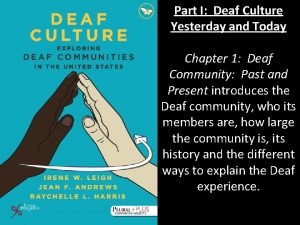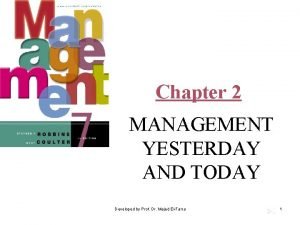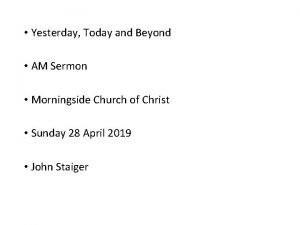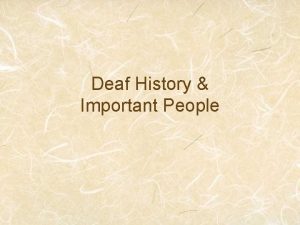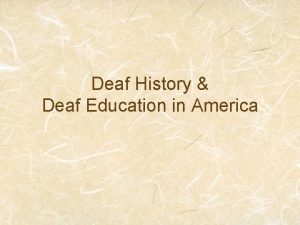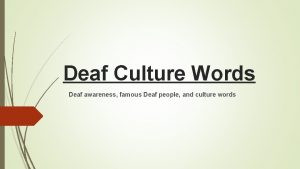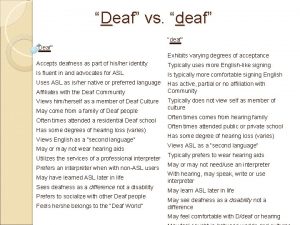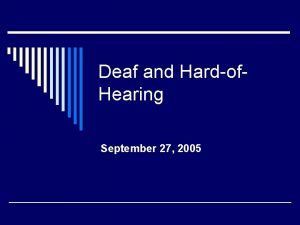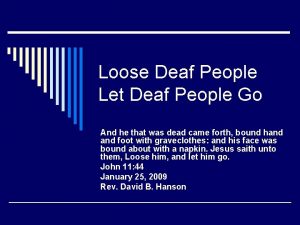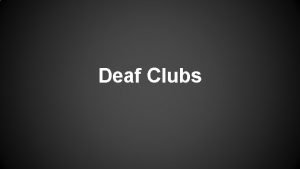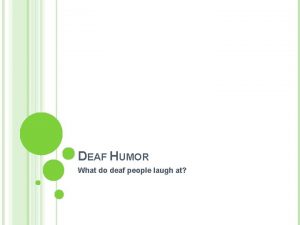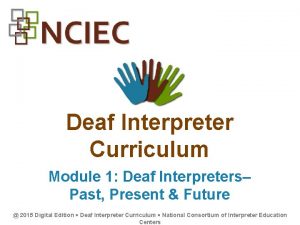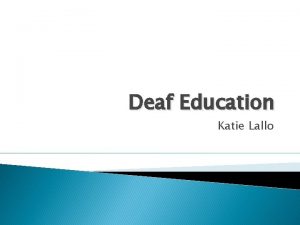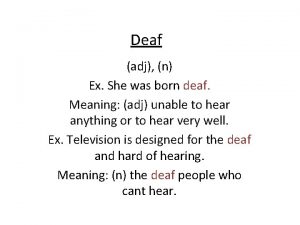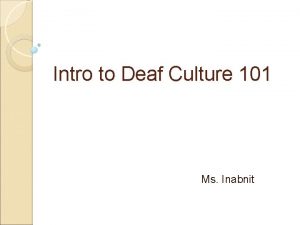Part I Deaf Culture Yesterday and Today Chapter


































- Slides: 34

Part I: Deaf Culture Yesterday and Today Chapter 2: Causes of Being Deaf and Auditory Innovations discusses genes that cause differences in hearing levels. Deaf people share their experiences in hearing and speech centers and working with audiologists.



“Hearing” • Deaf people label people who can hear and speak, “Hearing” or “Hearing people. ” • “Hearing world” is another phrase that refers to spaces populated by hearing people. • Fast food drive-through, apartment intercoms and speakers are examples of designs for the “hearing world”. (Leigh, Andrews & Harris, 2018, p. 27) © Plural Publishing, Inc. 2018

Audiologists and Audiograms • Approximately 48 million Americans have some sort of difficulty hearing. • A person with a hearing loss is referred to an audiologist. • An audiologist specializes in detecting hearing levels and proposing different types of accommodations. (Leigh, Andrews & Harris, 2018, p. 27) © Plural Publishing, Inc. 2018

Audiologists and Audiograms The field an audiologist works in is called audiology. (Leigh, Andrews & Harris, 2018, p. 28) © Plural Publishing, Inc. 2018

Audiologists and Audiograms During an audiological evaluation in a soundproof room, the audiologist in an adjacent room will turn on a machine that emits sounds and watch for responses from the client. (Leigh, Andrews & Harris, 2018, p. 29) © Plural Publishing, Inc. 2018

This is an audiogram that shows the frequency and loudness levels of different sounds. Compare the audiograms of a deaf and hearing person next. (Leigh, Andrews & Harris, 2018, p. 30)


“Hearing” is not an exact science According to Raychelle’s audiogram, she has a 95 – 100 d. B hearing loss, which means she shouldn’t be able to hear her Rottweiler bark. (Leigh, Andrews & Harris, 2018, p. 30, 32 & 34)

Hearing Levels (Leigh, Andrews & Harris, 2018, p. 34) © Plural Publishing, Inc. 2018

Hearing Levels • Deaf people are required to submit audiograms to qualify for Deaflympics; receive benefits or be eligible for admission at a deaf school. • Hard-of-hearing people vary greatly in how much they can hear or understand. They may be able to hear men (low-frequency) but not women (high-frequency). • Some can speak, and some can understand speech. Both are separate skills, and not all can do both. (Leigh, Andrews & Harris, 2018, p. 35) © Plural Publishing, Inc. 2018

Hearing Levels • Prelingual: Deaf before learning spoken language. • Postlingual: Becoming deaf after learning spoken language. People who become deaf later usually remember what it is like to speak and hear. • Reading lips is the most ineffective means of communication with a deaf person. Try other approaches such as gesturing or drawing. (Leigh, Andrews & Harris, 2018, p. 35) © Plural Publishing, Inc. 2018

Changes in Hearing Levels • Congential loss: Hearing loss before/at birth. • Acquired loss: Hearing loss after birth, e. g. meningitis, fetal alcohol syndrome, aging. • Conductive loss: Problems in the outer and middle ear, e. g. ear infection, q-tip puncture. This is usually temporary. • Sensorineural loss: Problems inside the ear or with the auditory nerve, e. g. missing cochlea hair. Usually permanent. (Leigh, Andrews & Harris, 2018, p. 36 -38) © Plural Publishing, Inc. 2018

Diagram of the Ear (Leigh, Andrews & Harris, 2018, p. 37) © Plural Publishing, Inc. 2018

Genetic Causes • Inherited genes or gene mutations cause 50% of the babies to be born deaf or become deaf later in life. • Scientists have identified over 400 different genes. • 2/3 of the genes are nonsyndromic, meaning the person is only deaf without any other physical changes, e. g. Connexin 26. • 1/3 include additional disabilities such as progressive blindness or pigment abnormalities. (Leigh, Andrews & Harris, 2018, p. 36) © Plural Publishing, Inc. 2018

History of Auditory Technology • For many centuries, Deaf people were coerced, tortured or killed by hearing people trying to “cure” deafness. • Babies would be abandoned, killed or imprisoned. • Many of the “cures” only increased the damage. Examples include pouring hot oil with boiled worms in the ear or an operation on the tongue to “unleash” their tongue. (Leigh, Andrews & Harris, 2018, p. 38) © Plural Publishing, Inc. 2018

Miracle cures, which include magnetic head caps, vibrating machines, artificial eardrums, blowers, inhalers, massagers, magic oils and balms with promises for permanent cures were sold by get-rich-quick sleazy medicine men. (Leigh, Andrews & Harris, 2018, p. 38)

History of Auditory Technology • Most of those cruel techniques have been abandoned, thankfully. Unfortunately many deaf adults remember being forced to speak English and their hands being whipped with a ruler when they tried to sign. • The prohibition for deaf children from signing is still happening today. The misconception is that signing will prevent deaf children from speaking. This is not true. (Leigh, Andrews & Harris, 2018, p. 39) © Plural Publishing, Inc. 2018

History of Auditory Technology The earliest “hearing aids” would come in the form of a ear trumpet, used to amplify sound. In the early 1950 s, the first hearing aid was worn on the chest. (Leigh, Andrews & Harris, 2018, p. 39) © Plural Publishing, Inc. 2018

History of Auditory Technology • The Food and Drug Administration (FDA) approved cochlear implant surgery in 1984, for children ages 2 and up in 1990, and in 2002, for children 1 year old and up. • Many of those recipients did not know what they were going in surgery for. • They share their traumatic stories online with each other, including side effects such as vertigo, severe headaches, and/or facial paralysis. (Leigh, Andrews & Harris, 2018, p. 40) © Plural Publishing, Inc. 2018

History of Auditory Technology Cochlear implant surgery requires extensive speech training, taking away valuable time from education and recreation. Surgical scars today are much less obvious. An example of the scarring from surgery in the 1980 s is shown here --> (Leigh, Andrews & Harris, 2018, p. 40) © Plural Publishing, Inc. 2018

Current Auditory Technology • There are now fewer side effects, if any. • As of 1990, hearing screening is now required in all 50 states at birth. • Some might wonder how parents could miss signs that an infant may be deaf. Babies can feel and see movement, vibrations or breezes, e. g. a door being slammed, and the baby is startled, leading parents to think the baby is hearing. Parents can be fooled as late as 2 ½ or 3 years old, with the child losing valuable language access. (Leigh, Andrews & Harris, 2018, p. 41) © Plural Publishing, Inc. 2018

Current Medical Field • Employees in the medical field often do not receive training about sign language and Deaf culture, and the serious impact of not providing a deaf child with sign language early in life. • The risks of depriving a deaf child of access to sign language include cognitive, social and academic delays. (Leigh, Andrews & Harris, 2018, p. 42) © Plural Publishing, Inc. 2018

Current Medical Field • New research shows that signing helps some Deaf children learn how to speak faster than prohibiting Deaf children from signing and trying to train them to speak. • Being bilingual (or even multilingual) in multiple languages is beneficial for everyone. (Leigh, Andrews & Harris, 2018, p. 43 -44) © Plural Publishing, Inc. 2018

Hearing Aids Hearing aids are external devices that amplify sound. Some are worn behind the ear, inside the ear, or on the frames of eyeglasses. Digital hearing aids now can eliminate background/environmental noise and amplify specific sounds such as human voices. (Leigh, Andrews & Harris, 2018, p. 44) © Plural Publishing, Inc. 2018

Cochlear Implants Cochlear implants require surgery to insert a coil, attached to the auditory nerve. A magnet is inserted behind the skin so the external hearing aid can attach magnetically. Sound is not amplified. Sound is transmitted directly to the auditory nerve. (Leigh, Andrews & Harris, 2018, p. 45 -46)

Hidden Costs of Cochlear Implants Cochlear implant surgery and cochlear implants are extremely expensive (around $100, 000). Lost cochlear implants can range around $10, 000. Implantees have to re-train their brains to recognize new sounds produced by electrical impulses. This requires time and dedication, ability to get off work, travel to the audiologists and numerous additional commitments. (Leigh, Andrews & Harris, 2018, p. 46) © Plural Publishing, Inc. 2018

Disability Porn There are often videos showing people of various ages having their implants turned on, and they seem to be crying happily. That does not represent the experience of many. This is considered “disability porn”, intended to make the viewer feel good. Many in the Deaf community are frustrated by these videos, giving the illusion that cochlear implants are a miracle. They are not. They require a lot of work. (Leigh, Andrews & Harris, 2018, p. 47) © Plural Publishing, Inc. 2018

Honesty vs. Profit Not only that, cochlear implants have a shelf life of 10 years. Technology changes rapidly. Recipients may have to go in for multiple surgeries to replace, update or upgrade the device. Lost & broken devices add to the overall total cost. Some Deaf community members want the medical community to be honest about the pros and cons of receiving a cochlear implant. Some view the cochlear implant industry as not willing to let go of a billon dollar industry. (Leigh, Andrews & Harris, 2018, p. 48 -49) © Plural Publishing, Inc. 2018

Marriage Tendencies Linguistic homogamy: Tendency of people to marry people who speak the same language (e. g. Deaf people and sign language) Ethnic homogamy: Tendency of people to marry people who share same ethnic/cultural background (e. g. Deaf culture) (Leigh, Andrews & Harris, 2018, p. 49 -50) © Plural Publishing, Inc. 2018

Genetic Engineering Over 400 genes cause deafness. Only a few dozen have been identified. The most popular gene that causes deafness is called connexin 26. There are pros and cons for genetic/prenatal testing. Parents can try to prevent or prepare for complex medical conditions associated with certain genes. (Leigh, Andrews & Harris, 2018, p. 49 -50) © Plural Publishing, Inc. 2018

Genetic Engineering Sperm banks delete donors that may have genetic complications. In Australia, a couple discarded embryos carrying the connexin 26 gene. A Deaf lesbian couple wanted to have a Deaf baby so instead of going to a sperm bank, they asked a Deaf man carrying the connexin 26 gene, and they had a Deaf daughter. Compare and contrast both stories above. Is this a form of Eugenics? Cultural genocide? (Leigh, Andrews & Harris, 2018, p. 50 -51) © Plural Publishing, Inc. 2018

Conclusion Non-deaf people: Approach “hearing” with an open mind and listen to deaf and hard of hearing people and their experiences and preferences. By eliminating disability (rather than creating accessibility), we are interfering with the natural variations of life, biodiversity and ecosystem. (Leigh, Andrews & Harris, 2018, p. 50 -51) © Plural Publishing, Inc. 2018
 James denison deaf
James denison deaf Management yesterday and today
Management yesterday and today Agriculture- yesterday today and tomorrow
Agriculture- yesterday today and tomorrow Yesterday, today and forever sermon
Yesterday, today and forever sermon Today's problems come from yesterday's solutions
Today's problems come from yesterday's solutions Yesterday is a lesson today is
Yesterday is a lesson today is Royal family yesterday today is tomorrow
Royal family yesterday today is tomorrow For todays meeting
For todays meeting What about today's class
What about today's class Meeting objective
Meeting objective Galton details
Galton details Today's lesson or today lesson
Today's lesson or today lesson Today's lesson or today lesson
Today's lesson or today lesson Ethnocentrism examples
Ethnocentrism examples Continuous culture and batch culture
Continuous culture and batch culture American vs indian culture
American vs indian culture Uses of selenite f broth
Uses of selenite f broth Folk culture and popular culture venn diagram
Folk culture and popular culture venn diagram How does popular culture diffuse
How does popular culture diffuse Indole test
Indole test Homework due today
Homework due today Stab culture and stroke culture
Stab culture and stroke culture Lawn or carpet culture method
Lawn or carpet culture method Surface culture deep culture and esol
Surface culture deep culture and esol The world today part 1
The world today part 1 Dr andrew foster deaf
Dr andrew foster deaf First deaf teacher in america
First deaf teacher in america First deaf pilot
First deaf pilot Affirmative de'via art
Affirmative de'via art Deaf icd 10
Deaf icd 10 Aristotle deaf
Aristotle deaf First deaf school in america
First deaf school in america Dr andrew foster deaf
Dr andrew foster deaf Open the blind eyes unlock the deaf ears
Open the blind eyes unlock the deaf ears Asl m
Asl m
